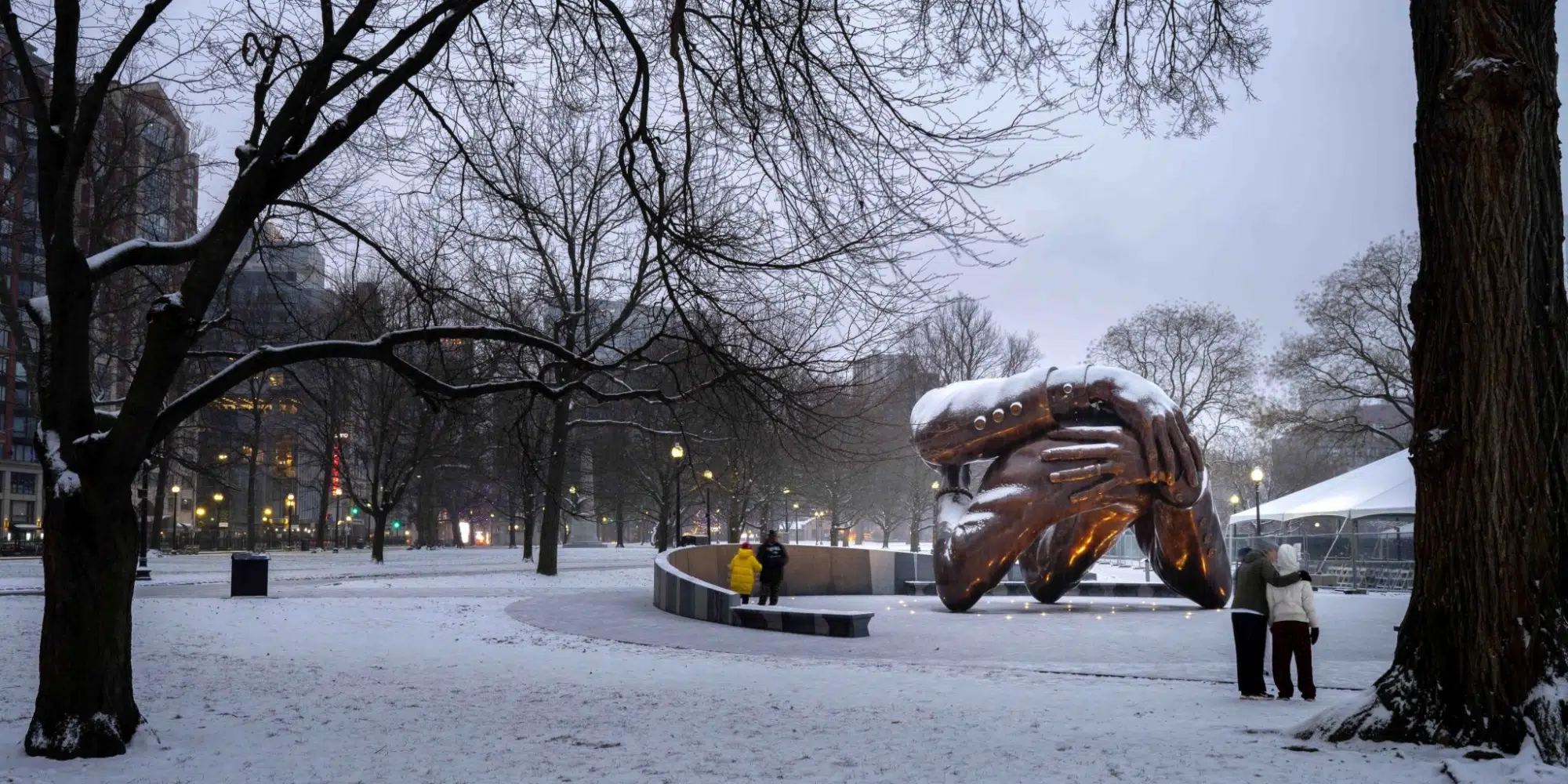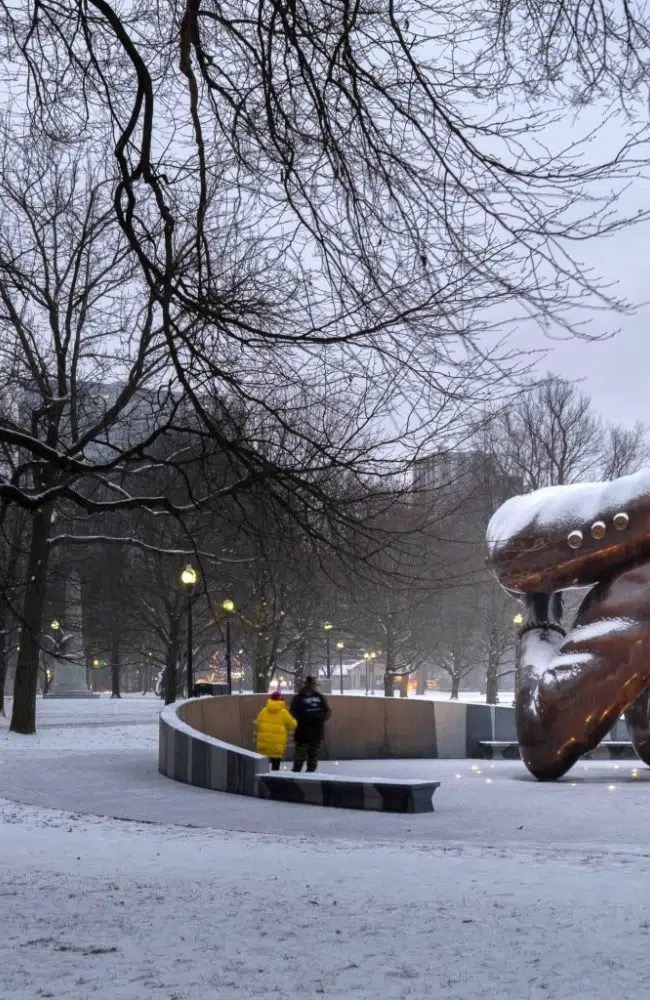In this month’s At the Helm, our Senior Consultant Lynn Shevory spoke with Imari Paris Jeffries, the Executive Director of Embrace Boston. Imari reflects on The Embrace memorial’s impact a month after its unveiling, Boston’s complex history and promising future, and how the organization is working at the intersection of arts and culture, community, and research to build a radically inclusive and equitable city.
Lynn: It’s been a month since The Embrace was unveiled in Boston Common, and I’m sure it’s been a whirlwind! When you take a moment to reflect, what moments have been the most rewarding?
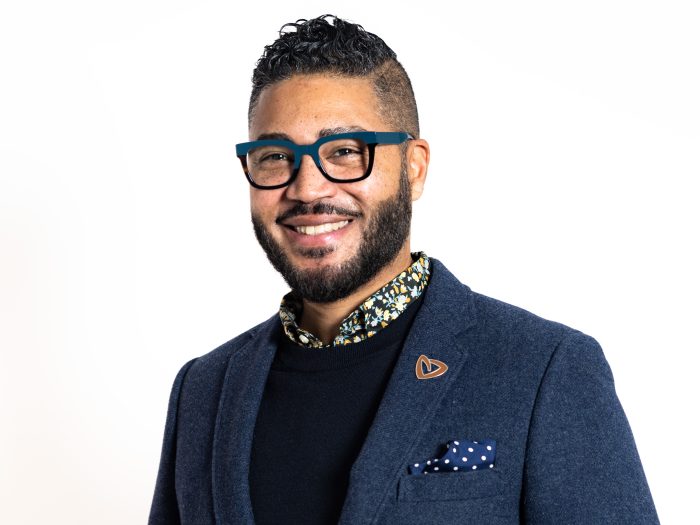 Imari: The most rewarding moments have been hearing and feeling people’s reactions to The Embrace. In my role as the chief storyteller, fundraiser, and cheerleader, I’ve had the chance to hear 1,000+ stories about what Dr. King and Mrs. King have meant to people – for different reasons and at different points in their lives. They’ve shared the quotes that stayed with them and how their words have inspired them – so to be here now, seeing people experience this memorial has been very meaningful. We also honored 69 other unsung heroes on the 1965 Freedom Plaza which surrounds The Embrace. Having the chance to meet some of those people and their families and see their reactions, that has been so rewarding, too. And overwhelming.
Imari: The most rewarding moments have been hearing and feeling people’s reactions to The Embrace. In my role as the chief storyteller, fundraiser, and cheerleader, I’ve had the chance to hear 1,000+ stories about what Dr. King and Mrs. King have meant to people – for different reasons and at different points in their lives. They’ve shared the quotes that stayed with them and how their words have inspired them – so to be here now, seeing people experience this memorial has been very meaningful. We also honored 69 other unsung heroes on the 1965 Freedom Plaza which surrounds The Embrace. Having the chance to meet some of those people and their families and see their reactions, that has been so rewarding, too. And overwhelming.
The monument is bringing people happiness and joy. That’s what we set out to create. Every time I go on social media or read an article about how people are reacting to The Embrace, how they’re experiencing it together with their families and friends – it’s very heartening.
I can only imagine. Especially because you never know how people will respond to art – whether it will truly move them or not.
That’s right. And there were some negative responses, initially. We are at a point in our country where we are engaged in a culture war, so what does it mean to build a memorial dedicated to love? It produced strong reactions. Everyone is entitled to their opinions, but I think the overwhelming feeling of folks is that they are excited and happy to have this memorial in Boston. It serves as a symbol of the promise we collectively make to create a city where everyone belongs and feels welcomed.
That makes me think about the memorial’s location. The Boston Common is so central and it’s in an area that tourists walk through daily. It feels like the perfect location to capture that energy of welcoming and belonging.
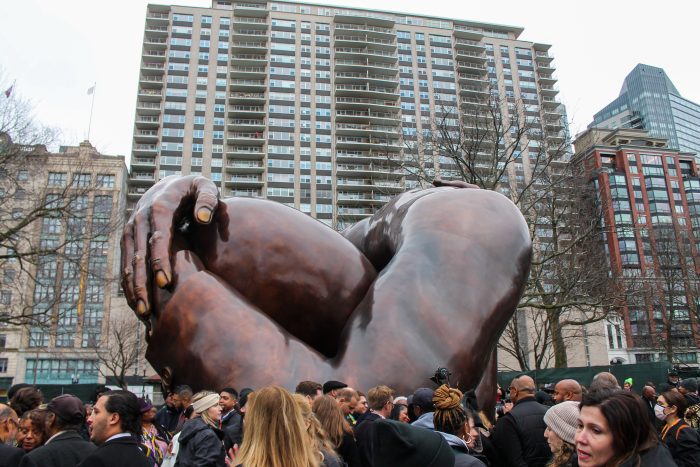 Right. The Boston Common is part of the Emerald Necklace, a network of parks and waterways designed by landscape architect Frederick Law Olmsted. He’s a renowned architect, who designed many well-known parks, including Central Park. So, to have The Embrace be one of the central attractions of Olmsted’s necklace—the crown jewel, if you will—was very important to us. It’s part of the Freedom Trail, it’s part of the Black Heritage Trail, and it’s in central Boston, where so many of our historic sites are. The fact that people can now come to Boston and experience a completer and more robust story of freedom in this city, I think it’s so important. There are so many national and international leaders who have resided and worked in Boston – I’m glad we could represent and memorialize some of them in the Common.
Right. The Boston Common is part of the Emerald Necklace, a network of parks and waterways designed by landscape architect Frederick Law Olmsted. He’s a renowned architect, who designed many well-known parks, including Central Park. So, to have The Embrace be one of the central attractions of Olmsted’s necklace—the crown jewel, if you will—was very important to us. It’s part of the Freedom Trail, it’s part of the Black Heritage Trail, and it’s in central Boston, where so many of our historic sites are. The fact that people can now come to Boston and experience a completer and more robust story of freedom in this city, I think it’s so important. There are so many national and international leaders who have resided and worked in Boston – I’m glad we could represent and memorialize some of them in the Common.
In an interview with NBC10 Boston, you spoke about the important role the sculpture plays in celebrating the diversity of this city and reflecting a sense of belonging for people of color. Can you expand on this? What do many people fail to understand or not realize about the history and current diversity of Boston?
Boston is one of our country’s most compelling storytelling cities. Like all cities in the U.S., it shares in our nation’s history of enslavement. And Boston has had a reputation. When we see images of the 1974 desegregation busing crisis, there’s a reason for folks to say Boston is racist. Or when we hear about people acting certain ways at sports arenas, there’s another reason to see Boston as racist. At the same time, Boston is a city of abolitionists and freedom fighters; it was a bastion of the north. And I think there has been a lot of transformation here. Today, almost every single major elected official in Boston is a woman or a person of color: the governor, lieutenant governor, attorney general, mayor, superintendent of police, and state attorney. Not to mention statewide officials, including Congresswoman Ayanna Pressley and Senator Elizabeth Warren. We have amazing female leaders leading our state, our cities, our municipal offices – and they are doing it with thoughtfulness and compassion. That excites me.
I think about this, too: 51% of Boston’s population is people of color, and 24% is Black. It’s a diverse place, and I think some people are holding on to a history that has changed. I’m pretty optimistic about our city. I think if Boston can change, and if Boston—as one of our storytelling cities—can tell a complete, inclusive story, then I think America as a whole can change to better reflect its rich diversity.
Speaking of the city’s future, Boston will turn 400 years old in 2030. Do you have a vision for the future the city should be working towards?
I think people from 50 years ago wouldn’t recognize Boston today – not only because of the development of the Seaport and other neighborhoods, but because of the inclusive nature of our leadership and the sense of belonging that the city is slowly but surely evolving to represent. I hope that by the time 2030 arrives, anyone who enters Massachusetts will experience a real level of justice and welcoming. And even before then, we have our nation’s 250th birthday in 2026. Our country has four true storytelling cities—Washington, DC, Philadelphia, New York City, and Boston—and these are the cities where our origin story began. These cities must be at the forefront of demonstratable change as we near these big dates. And I think we are already seeing this – in the emergence of civic leaders, elected leaders, and monumental policies.
We know that art can play a critical role in creating cultural and societal change. From your perspective, how are public art and sculpture special in this regard?
Monuments and memorials are analog cookies. Folks are familiar with digital cookies. I’m shopping online for shoes, I click “accept cookies” on one of the websites I’m browsing on, and then for the rest of the day, every single ad I see is of the shoes I viewed. By the end of the day, I end up buying the shoes.
 Monuments work in the same way. They represent a set of values or individuals (who also represent certain values). Who or what is worthy of being memorialized? What is represented when we do so? The values and spirits of those we memorialize are the analog cookies that shape our society’s existence and thinking. There are 780 confederate memorials in the U.S., and more than half of them were built between 1902 and 1908, well after the war ended. Why? Well, those memorials were erected to tell a story: to reimagine the Civil War as a war of a lost cause. These memorials were built on a legacy of hatred, of enslaving people. We have 320 schools named after confederate leaders. What would it be like to go to Robert E. Lee High School? How does it feel as a student to know your school honors someone who wanted to maintain an institution that enslaved people?
Monuments work in the same way. They represent a set of values or individuals (who also represent certain values). Who or what is worthy of being memorialized? What is represented when we do so? The values and spirits of those we memorialize are the analog cookies that shape our society’s existence and thinking. There are 780 confederate memorials in the U.S., and more than half of them were built between 1902 and 1908, well after the war ended. Why? Well, those memorials were erected to tell a story: to reimagine the Civil War as a war of a lost cause. These memorials were built on a legacy of hatred, of enslaving people. We have 320 schools named after confederate leaders. What would it be like to go to Robert E. Lee High School? How does it feel as a student to know your school honors someone who wanted to maintain an institution that enslaved people?
Now, what values does The Embrace memorialize? The inspiration was Dr. King and Mrs. King embracing when they found out that Dr. King had won the Nobel Prize. He immediately, as many of us would, hugged the person he loved most, Mrs. King. The photo of them radiates with love. That’s the value we wanted to capture with the memorial. And we need more memorials that represent love. Because memorials do as digital cookies do – they demonstrate and convince people of specific values. I think that public art allows us to be very intentional in spreading this value. That’s why we wanted The Embrace to be in such a public space.
I love how the memorial has this conceptual aspect, but it’s also so approachable. It’s not overly instructive. People can access and experience it in a very unique and authentic way.
The artist Hank Willis Thomas talks about feeling like you are in the center of a hug. The memorial is meant to be touched; it’s meant to be smelled; and its appearance will evolve as the patina ages.
We have created what we refer to as an “eyes up” digital experience to complement the sculpture itself. There’s an app that we recommend people use when visiting The Embrace. There are audio stories voiced by distinguished Bostonians, and there are gateway markers—which are also presented in braille—as you walk around The Embrace, so you know when to listen to each story. The stories are meant to help people conceptualize what’s in from of them, but they are also to ensure the memorial is accessible and inclusive. From our focus groups, we heard how people who are hard of seeing or blind use their handheld phones to see – so that informed how we built the app. We also wanted folks for whom English isn’t their first language to be able to fully experience the memorial. So, the app’s content is translated into Haitian Creole, Spanish, and Mandarin.
We know people will continue to come back to the monument for years. So, we thought that a monument that embodied inclusion and love, as opposed to solely representing an individual, was the type of monument that would have real staying power.
While naturally most people are familiar with Embrace Boston because of the memorial, your organization’s scope is greater, and focuses on areas such as cultural representation and research & policy. Can you share more about this?
In 2020, in the super dark days of the pandemic before the vaccine was available, one of the things that was front and center for everyone was survival. We didn’t know what was happening, and many of us were kind of scrambling to understand what our existence meant. And then at the same time, there was the racial reckoning of that summer in response to the murders of George Floyd, Breonna Taylor, and Ahmaud Arbery. People were marching to say hey, we have to do better as a society. We were seeing how racism was causing very real harm – and that was true with COVID too, as communities of colors that lacked social safety nets were hit especially hard. I think people developed a sense of consciousness around these issues in a way that didn’t exist before. Embrace Boston was in the center of all this.
Our research and policy work focuses on the seven harms of racism. They are:
- Culture, symbols, and personhood
- Criminal justice
- Transportation
- Housing
- Education
- Wealth
- Health
Each of these areas has been negatively impacted by racism. We are pushing to create policies, in collation with communities, that mitigate these harms and improve the lives of people of color.
One of our big projects right now is the festival we’re planning for Juneteenth. We want the festival to create a greater sense of inclusivity around the holiday, so it’s not seen as a holiday that only Black people should care about and celebrate. Think about it like this – even if you aren’t a father yourself, you likely have a father or you are friends with a father or you know fathers in your community, so on Father’s Day, you still join in and eat pancakes, drink mimosas, and center fathers. And on that day, we don’t ask, “Well, what about celebrating cousins? What about celebrating trees?” We all have no issue celebrating fathers for a day. But racism unfortunately has a way of creating zero-sum thinking where people feel like if one group gets something, another group must lose something. How do we change that? How do we all celebrate Juneteenth—which was America’s first true Independence Day, where every single individual was entitled to freedom—and have everyone eating pancakes and drinking mimosas? We are hoping that the Embrace Juneteenth Festival will provide our communities with rituals and customs to help celebrate the holiday, including those of us who aren’t Black. Let’s make it a holiday of learning, of ideas, of enjoying music and meeting new friends – all while centering the Black community. If we can all celebrate St. Patrick’s Day—even those of us who don’t have Irish descent—I think we can do the same for Juneteenth.
Basically, you’re baking more of those analog cookies.
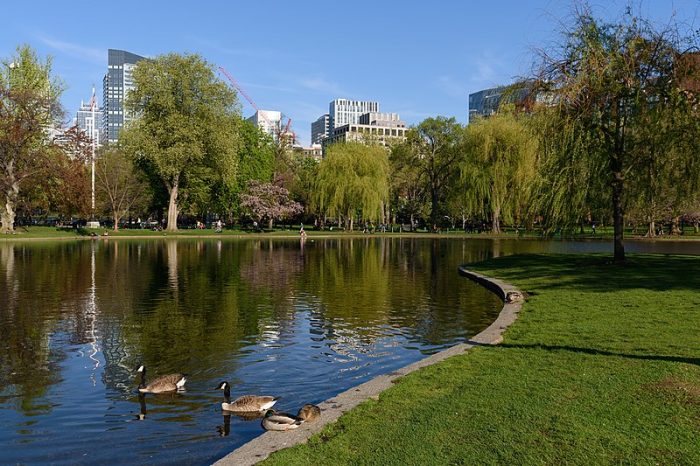 That’s right. I think you can’t leave culture to chance. When the daughters of the American Confederacy were building those 700+ memorials, they weren’t leaving anything to chance. There was an intention; they wanted to tell a story of the lost cause instead of a story about being pro-slavery. They were pushing a specific narrative, and in many cases, it worked. There are some people who really feel that those confederate statues are a part of their heritage. They ate the cookies—they bought the shoes—if you will. So, I think we need to build more monuments and events based on different values – values of inclusion, love, belonging, unity. We talked about it earlier; we’re close to the 250th anniversary of our country and the 400th anniversary of Boston. This is a chance to level set, to restart. Let’s lean into the conversation.
That’s right. I think you can’t leave culture to chance. When the daughters of the American Confederacy were building those 700+ memorials, they weren’t leaving anything to chance. There was an intention; they wanted to tell a story of the lost cause instead of a story about being pro-slavery. They were pushing a specific narrative, and in many cases, it worked. There are some people who really feel that those confederate statues are a part of their heritage. They ate the cookies—they bought the shoes—if you will. So, I think we need to build more monuments and events based on different values – values of inclusion, love, belonging, unity. We talked about it earlier; we’re close to the 250th anniversary of our country and the 400th anniversary of Boston. This is a chance to level set, to restart. Let’s lean into the conversation.
I’d love to learn more about your personal path to Embrace Boston. Before becoming Executive Director in 2020, you held CEO and other senior leadership roles at an array of organizations, including Parenting Journey, Italian Home for Children, Jumpstart, and Boston Rising, to name a few. How did your past experiences lead you to Embrace Boston?
One of my mentors always told me how important it is to make relationships as a nonprofit professional. So many of the challenges we are working to eliminate—the housing crisis, educational disparities, racial inequity, environmental issues—take many years to address, so it’s a long game, and relationships will help you along the way.
I’m about to turn 50 years old next month. So many of Embrace Boston’s supporters are people that I met in my early 20s, when I was just starting my career. I’m very grateful for those relationships. I also think the range of experiences I had helped us find programmatic and philanthropic success. I’ve been a frontline employee. I’ve been an advancement professional. I’ve learned how to raise resources, build trust, and steward people’s time, talent, and treasure. I have been a student of other leaders. It’s paved a way.
I think that’s helpful to hear for early career nonprofit professionals.
I would say this, too: you can if you want to, but do not feel like you have to lock into one area of need. The areas of need are all interrelated. We exist in an environment. We get to places through transportation. When we’re at work and at home, we need to eat. At our jobs and in our communities, interact with different cultures. So, we’re all involved in issues of the climate, infrastructure, food security, diversity, etc. That’s part of being human. Don’t lock yourself into one area. I have personally worked in early childhood education, mental health, the arts, and I have also been on the boards of environmental organizations and racial equity organizations. That’s allowed me to learn about a wide range of issues, and it’s an incredibly helpful way to supplement your knowledge. I give people the same advice all the time: if you have the opportunity to join a nonprofit board, join a committee for an area you aren’t knowledgeable about – whether that’s programming, development, finance, etc. Embrace the opportunity to learn and add to your toolbox.
And what advice would you offer to fellow leaders?
Well, I’m terrible at it, but my advice is to take time off to recharge. I’m trying to be better at it myself. We need to practice good self-care. I know that it’s hard to do because we care about the work and the mission so much, but it’s necessary for our longevity.
What’s on the horizon for Embrace Boston?
There are a number of big projects we are working on. We are part of a team that is developing a 7.8-acre portion of land – a microneighborhood. We will be building another memorial, as well as an arts and culture center. We envision it being a gathering spot; there will be an art gallery, studio space, and a live music theater venue. That will take three to four years to complete.
In the nearer future, we have a substantial piece of research coming out this spring, called the Full Harm Report. It focuses on the seven harms of racism I previously mentioned. We hope it will help people understand how those harms are interrelated and conceptualize their work through this lens.
We are also involved in reparations for those seven harms. The City of Boston had an ordinance approved, and they just appointed one of our staff members to the commission to study reparations. And on a statewide level, a similar bill in process. Too often, reparations also produce this zero-sum thinking. It’s about a poverty of empathy. I think there’s an opportunity to shift that mindset. We need people to understand that if one person becomes whole, another person doesn’t become less than. Reparations offer an opportunity to acknowledge our country’s history of slavery, how it made some groups not whole, and allow us to address that. I think we all, as Americans, want a society where education is available, healthcare is effective, and people have a right to live freely and safely – in whatever form that looks like. I think it’s a future we can achieve.
Ultimately, The Embrace is big – it’s two stories high and four stories wide. But it’s only a small part of this ecosystem. There are leaders and advocates who have been doing the work long before The Embrace. I like to think we are just part of the wave, and hopefully, we have created a ripple that will continue – even after you and I are long gone.

